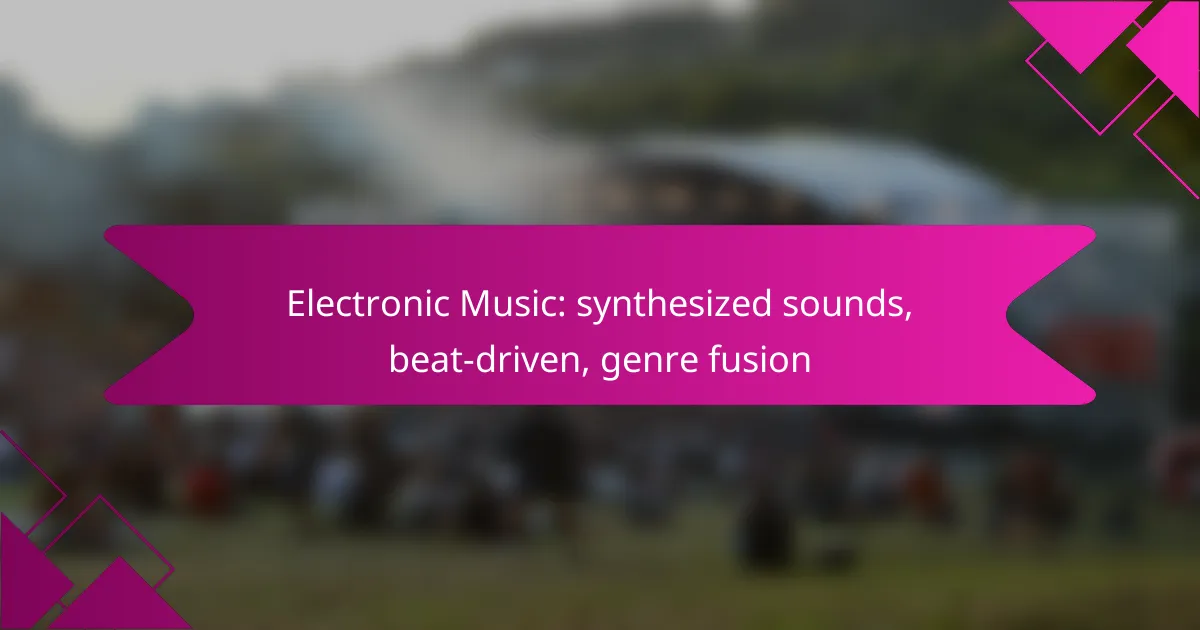Electronic music is a dynamic genre characterized by synthesized sounds and beat-driven rhythms, often created using advanced technology such as digital audio workstations and synthesizers. This genre thrives on the fusion of various musical styles, drawing influences from house, techno, and drum and bass to produce intricate and engaging soundscapes.

How to create electronic music?
Creating electronic music involves using technology to produce sound, often characterized by synthesized tones and rhythmic beats. Key components include digital audio workstations (DAWs), synthesizers, and layering techniques to craft unique tracks.
Using digital audio workstations like Ableton Live
Digital audio workstations (DAWs) like Ableton Live are essential tools for creating electronic music. They allow you to record, edit, and arrange your sounds in a user-friendly environment. With features like MIDI sequencing and audio manipulation, DAWs provide a versatile platform for experimentation.
When using Ableton Live, familiarize yourself with its interface and workflow. Start by exploring the session view for live performance or the arrangement view for detailed editing. Utilize built-in effects and instruments to enhance your sound without needing additional plugins.
Incorporating synthesizers and samplers
Synthesizers and samplers are crucial for generating unique sounds in electronic music. Synthesizers create sounds through oscillators, filters, and modulation, allowing for a wide range of tonal possibilities. Samplers, on the other hand, record and manipulate audio clips, enabling you to incorporate real-world sounds into your tracks.
Experiment with different types of synthesizers, such as subtractive, additive, or FM synthesis, to find the right texture for your music. Use samplers to layer vocal snippets or environmental sounds, adding depth and character to your compositions.
Layering beats and melodies
Layering beats and melodies is a fundamental technique in electronic music production. Start by establishing a solid drum pattern, then gradually add melodic elements to create a rich soundscape. Consider using a combination of kick drums, snares, and hi-hats to build a dynamic rhythm.
When layering melodies, use contrasting sounds to create interest. For example, pair a bright synth lead with a warm pad to achieve a fuller sound. Keep an eye on the frequency spectrum to avoid muddiness; ensure each layer occupies its own space for clarity and impact.

What are the best software tools for electronic music production?
The best software tools for electronic music production include Ableton Live, FL Studio, and Logic Pro, each catering to different aspects of music creation. These platforms offer unique features that enhance live performance, beat making, and comprehensive production workflows.
Ableton Live for live performance
Ableton Live is renowned for its intuitive interface and powerful capabilities for live performance. Its Session View allows musicians to trigger clips and loops on the fly, making it ideal for improvisation and dynamic sets.
When using Ableton Live, consider its extensive library of built-in sounds and effects, which can be easily manipulated in real-time. Additionally, the software supports various hardware controllers, enhancing the live experience.
FL Studio for beat making
FL Studio is a popular choice for beat making, particularly in genres like hip-hop and electronic dance music. Its step sequencer and piano roll make it easy to create complex rhythms and melodies quickly.
For effective use, take advantage of FL Studio’s extensive plugin support, allowing you to integrate virtual instruments and effects seamlessly. The software’s user-friendly layout also helps beginners grasp music production concepts faster.
Logic Pro for comprehensive production
Logic Pro is a comprehensive digital audio workstation (DAW) favored by many professional producers. It offers a wide range of tools for recording, editing, and mixing, making it suitable for full music production projects.
Utilize Logic Pro’s advanced features like Flex Time and Flex Pitch for precise audio manipulation. The software also includes a vast library of loops and samples, which can enhance your productions significantly.

Which genres influence electronic music?
Electronic music is shaped by a variety of genres, each contributing unique elements that define its sound. Key influences include house, techno, and drum and bass, which together create a rich tapestry of synthesized sounds and rhythmic complexity.
House music as a foundational genre
House music serves as a cornerstone of electronic music, characterized by its repetitive 4/4 beat and synthesized melodies. Originating in the 1980s in Chicago, it emphasizes a steady tempo, often ranging from 120 to 130 BPM, making it ideal for dance floors.
Producers often incorporate soulful vocals and jazzy chords, which add depth and emotion to the tracks. The genre has spawned numerous subgenres, including deep house and progressive house, each bringing its own flavor while maintaining the foundational elements of house music.
Techno’s impact on sound design
Techno significantly influences sound design in electronic music, focusing on rhythm and texture over melody. Originating in Detroit in the 1980s, it typically features a faster tempo, usually between 120 and 150 BPM, and employs synthesized sounds that create a futuristic atmosphere.
Producers often use drum machines and sequencers to create intricate patterns and layers. The genre encourages experimentation with sound manipulation techniques, such as filtering and modulation, which can lead to innovative sonic landscapes.
Drum and bass for rhythm complexity
Drum and bass is known for its fast breakbeats and heavy basslines, typically ranging from 160 to 180 BPM. This genre adds a layer of rhythmic complexity to electronic music, often incorporating elements from jazz, funk, and reggae.
Producers focus on creating dynamic drum patterns and deep bass sounds, which can evoke a wide range of emotions. The genre’s emphasis on rhythm makes it popular in both club settings and live performances, where energy and engagement are paramount.

What are the key elements of synthesized sounds?
Synthesized sounds are primarily characterized by their waveforms, oscillators, and modulation techniques. These elements work together to create unique audio textures that define electronic music.
Waveforms and oscillators
Waveforms are the basic building blocks of synthesized sounds, representing the shape of the sound wave. Common types include sine, square, triangle, and sawtooth waves, each producing distinct tonal qualities. Oscillators generate these waveforms, allowing for continuous sound production at various frequencies.
When choosing oscillators, consider their ability to create harmonics and how they interact with other sound elements. For example, a sawtooth wave can produce rich, complex sounds that are ideal for basslines, while a sine wave is often used for smoother, more ethereal tones.
Filters and modulation techniques
Filters shape synthesized sounds by removing certain frequencies, thus altering the tone. Common filter types include low-pass, high-pass, band-pass, and notch filters. Each filter type can dramatically change the character of a sound, making it essential to experiment with different settings to achieve the desired effect.
Modulation techniques, such as amplitude modulation (AM) and frequency modulation (FM), add movement and complexity to sounds. By varying parameters over time, you can create evolving textures that keep the listener engaged. For instance, using an LFO (low-frequency oscillator) to modulate a filter cutoff can produce dynamic, sweeping sounds that enhance the overall musical composition.

How to market electronic music digitally?
To effectively market electronic music digitally, artists should leverage various online platforms to reach their target audience. This involves creating engaging content, building a strong online presence, and utilizing data analytics to refine marketing strategies.
Utilizing social media platforms like Instagram
Instagram is a powerful tool for electronic music marketing due to its visual nature and large user base. Artists can share snippets of their tracks, behind-the-scenes content, and live performance clips to engage followers.
Using features like Stories and Reels can enhance visibility and foster interaction. Collaborating with influencers or other artists can also expand reach and attract new listeners.
Engaging audiences on SoundCloud
SoundCloud is a key platform for electronic music, allowing artists to upload tracks and connect with fans. Engaging with listeners through comments and reposts can build a loyal community around your music.
Consider creating playlists that feature your tracks alongside similar artists to attract new listeners. Regularly updating content and promoting exclusive releases can keep your audience engaged.
Leveraging music streaming services
Music streaming services like Spotify and Apple Music are essential for reaching a broader audience. Artists should ensure their music is available on these platforms and optimize their profiles with engaging bios and images.
Utilizing playlist placements can significantly increase exposure. Submitting tracks to curated playlists can lead to higher streaming numbers and more followers. Regularly analyzing listener data can help refine marketing strategies and target specific demographics effectively.
